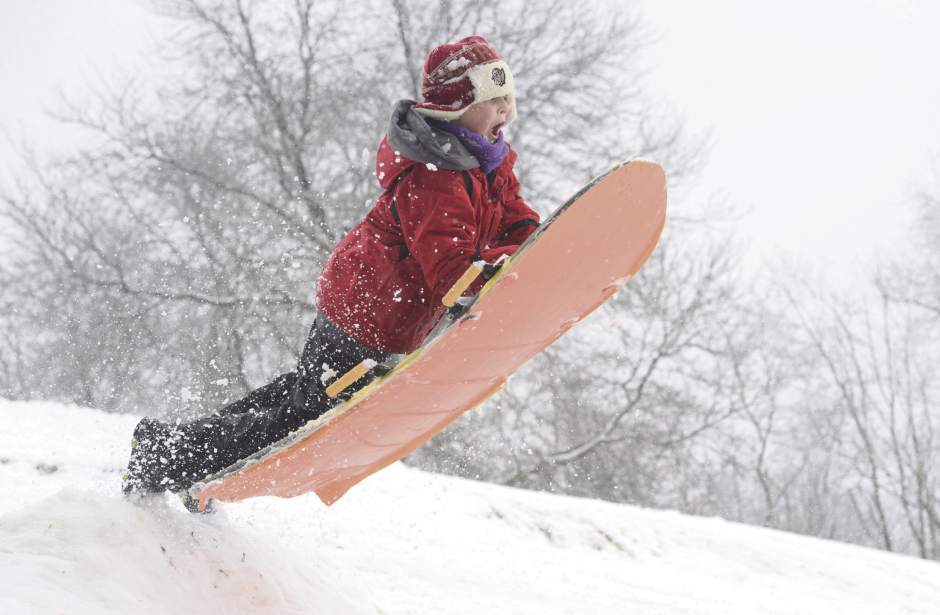School districts turn to tech to consider eliminating snow days
With nearly universal access to portable computers, school cancellations for snow days may be limited in the future — if not made obsolete.
A dozen Pennsylvania school districts are in the second year of a three-year test of what the state calls “flexible instructional days.” Students don't have to come to school, but they are given assignments that they're expected to complete within a few days.
Nicole Reigelman, a spokeswoman for the state Department of Education, said the practice will be evaluated after the end of the 2017-18 school year.
No Alle-Kiski Valley area districts are involved, but members of the Allegheny Valley School Board's education and technology committees met recently to talk about the possibility for their district.
Using such a day would allow students to get their work done so that the day would count toward the 180-day requirement under the state's school code and not have to be made up later.
But some people aren't convinced. Snow days are to school kids what “mental health” days are to adults who call off work, Nick Spehar said.
While technology can make it possible for kids to do their work at home on days when they can't get to school, Spehar is among those who don't think doing away with the snow day is a good idea.
“Snow days are fine,” he said while waiting to pick up his grandchildren recently at Acmetonia Primary School in Harmar. “You need a break every now and then.”
“Nobody likes going to school into June,” Allegheny Valley School Director Glenna Renaldi said.
Allegheny Valley Superintendent Pat Graczyk said it's something the district can look into. Administrators will update the school board.
Besides snow days, flexible days could be used in other situations where students can't be in school, such as when buildings don't have water, Graczyk said.
Allegheny Valley has enough computers for all of its students to take one home, said Janice Nuzzo, director of student achievement. The district is rolling out a one-to-one program through which ninth-graders, 10th-graders and 11th-graders have iPads. It will be expanded to seniors.
The district has laptops for lower grades.
“We have the technology here,” she said. “We already have enough technology to outfit every kid in the district.”
Students without computers or internet access at home would have two weeks to complete their assignments, Nuzzo said.
Pilot program in action
The Elizabeth-Forward School District, among the 12 in the pilot program, has given iPads to all of its roughly 2,300 students, which gave it the opportunity to be considered for the pilot, Superintendent Bart Rocco said.
The district did a trial run one day last school year but hasn't tried using it on a real snow day, Rocco said.
“I hope I never have to use it,” Rocco said. “It's better obviously to have the kids in school with their teachers in the classrooms. I think technology has provided us an opportunity to rethink how we do things.”
For the trial run, students worked at home, but teachers came to school.
Because the district wants teachers in school even if students are working at home, Rocco said his district is more likely to call a snow day when it's too dangerous for teachers to drive and make it up later.
A flexible day is more likely to be used in a situation where it's considered too cold to have students at bus stops, but the teachers can still get to the buildings.
That approach could change, he said.
“We're evaluating it. This is a new program,” he said. “That's why it's a pilot. We're looking at the positives and the negatives.”
Some parents want snow days
At Seneca Valley, also in the pilot program, administrators decided that the first two snow days will be made up, while flexible days would be used after that.
Half of parents surveyed wanted kids to still have an opportunity to go out and enjoy the snow, district spokeswoman Linda Andreassi said.
“Our hope is that it meets the interest of the parents who didn't want the traditional snow day to go away,” Andreassi said. “When we get to the third, fourth and fifth days and the novelty is wearing away, that's when the flexible instructional day will take place.”
Seneca Valley also tested the flexible day with a pre-planned day in the last school year. “We received a lot of feedback,” she said. “We were able to tweak the program for this school year based on a lot of the feedback we were getting from parents.”
With about 7,200 students, Seneca Valley is too large to be able to provide all students with a computer, Andreassi said.
The district found 98 percent of students have computer access at home.
Still, it recognizes there are those who, instead of that, don't or where there are more kids than devices, or that on a flexible day some working parents will put children in day care where they won't be able to do school work.
Andreassi said work can be done online, on paper or a combination.
And students will have the 10 school days to get work from that day completed.
While some students and parents will miss the traditional snow day, Andreassi said they may appreciate not having days added at the end of the school year.
“I guess we'll wait and see,” she said.
Brian C. Rittmeyer is a Tribune-Review staff writer. Reach him at 724-226-4701 or at brittmeyer@tribweb.com.


